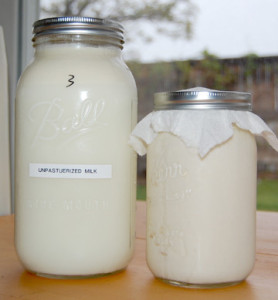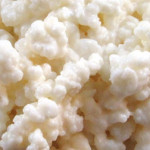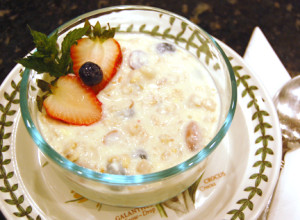Milk kefir: Milk that has been cultured (fermented) into a thick, creamy, tangy-sour, probiotic-filled smoothie.
Most people don’t know what milk kefir is, but with the growing movement towards whole foods and probiotics, kefir is coming into more public awareness. So much so, that it can now be bought in the dairy aisle of most grocery stores.
Lifeway (lifewaykefir.com) makes kefir in a variety of flavors and styles (low fat, whole milk, Greek, “green”), all containing pasteurized milk. My preference is for raw, unpasteurized milk because of all of the nutritional benefits (see my post on raw milk) that end up being killed by pasteurization. But you would have to culture your own raw milk in order to have raw milk kefir. If you are willing to make it yourself, it’s very easy.
You will need to buy kefir grains (living bacteria & yeast that look like little cauliflower florets) that will culture the milk into kefir. It’s just a matter of moving the grains to a container of fresh milk every day or so.
There are many health benefits of kefir:
• High probiotic content, superior to yogurt (30 strains of bacteria and yeast). Probiotics contribute to gut health, which means better digestion and absorption of vitamins and nutrients, also a stronger immune system and better mental health (read Gut & Psychology Syndrome for an explanation). It also contains lactobacillus kefir, which has strong antibacterial properties.
• Low or no lactose as the bacteria eat the lactose and convert it to lactic acid (hence the sour taste). If you are lactose intolerant, you should be able to drink kefir with no adverse effects.
• High in protein, calcium and B-vitamins. Vitamin K2 also, especially if using raw milk, which is the vitamin that helps your body utilize calcium (improved calcium absorption by bones and teeth).
• May protect against cancer by inhibiting tumor growth. See http://www.emeraldinsight.com/doi/abs/10.1108/00070700710736534
• Has been tied to improvement of allergy and asthma symptoms (especially if using raw milk)
I was having a hard time keeping up with drinking all the kefir I was making, which made me look for other ways to use this amazing elixir. I’m sharing some recipes I’ve either found or authored. Of course, if you are using kefir in a recipe that involves high heat (baking or cooking), the probiotics will be killed off. But there are plenty of ways to use it raw as well, and I no longer buy sour cream or buttermilk as kefir is a perfect substitute. Here I go:
• First on the list is, naturally, kefir to drink. I happen to like it plain, but if you don’t like “sour” you can add fruit, berries, stevia or honey and gently blend into a smoothie that will taste like yogurt. (See below.)
• Smoothies. Here’s a bunch of recipes: http://www.culturesforhealth.com/complete-guide-cultured-smoothies
• Breakfast “Pudding.” Kefir can be used as a base to make a healthy and satisfying breakfast. Adding a variety of muesli, fruit and nuts will keep it interesting. Mix it up! https://theherbanfarmer.com/recipe/breakfast-kefir-pudding/
• Use like sour cream or buttermilk: Add to a baked potato, top a soup (like borscht), mix into a cucumber salad. Kefir can be substituted for sour cream or buttermilk in your favorite recipes.
• Kefir cheese. When kefir cultures too long (warm days will speed up the process), it will start to separate into curds and whey. You can always stir them back together, but your drink will be a little lumpy. Especially if you’re using raw, unpasteurized and non-homogenized milk. The cheese is easy to “make.” Just get a large bowl and a clean cotton dish towel (or clean, never-been-used cotton diapers or cheese cloth) and some string. Line the bowl with several layers of the fabric, pour the separating kefir into it, tie the fabric ends together, and suspend it over the bowl. I tie mine to a cabinet knob. In a few hours most of the whey will be removed (you decide the consistency of the cheese by how long it hangs). The whey can be refrigerated for other uses.
You can add various seasonings and herbs to the cheese. Here’s a favorite recipe of mine that is meant to be a dip, but I spread it on crackers or vegetable slices. http://www.culturesforhealth.com/kefir-artichoke-dip-recipe
• Whey. The whey from making cheese can be refrigerated, I’ve read, for six months. It can be blended into smoothies or protein drinks, used as a catalyst for fermenting sauerkraut and other vegetables, diluted and used to water plants, composted, added to recipes as a thinner and, of course, used to water down your cheese if you overdid the draining process.
• Dips. Recipes from Cultures for Health—follow the links on this page for more recipes.
• Salad dressings, such as this Ranch Style
http://www.culturesforhealth.com/all-kefir-ranch-salad-dressing-recipe
• Cold soups, such as Okroshka or Cuke-Avocado
http://www.culturesforhealth.com/okroshka-recipe-cold-kefir-soup-russian
http://www.culturesforhealth.com/chilled-cucumber-avocado-kefir-soup
• Biscuits, such as my favorite FAST AND EASY einkorn kefir biscuits.
https://theherbanfarmer.com/recipe/quick-einkorn-kefir-buttermilk-biscuits/
• Coleslaw (or add to potato salad)
https://theherbanfarmer.com/recipe/milk-kefir-herbed-coleslaw/
More kefir recipes can be found here http://www.culturesforhealth.com/five-ways-to-use-kefir/
More in-depth information about milk kefir can be found here http://www.thegoodgut.org/kefir-the-elixir-of-youth-everything-you-need-to-know/
There are enough recipes here to get you started on incorporating milk kefir into your daily diet. Enjoy it in good health!




